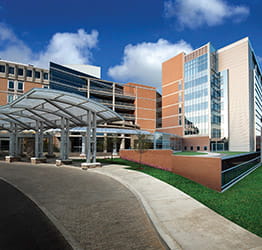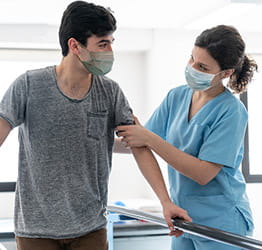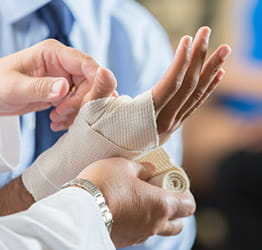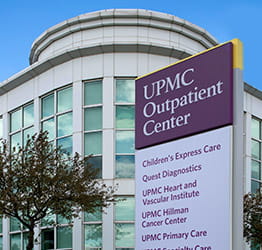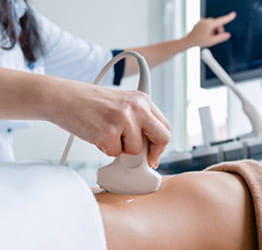Radiation oncology, also called radiation therapy, uses x-rays or other high-energy types of radiation to kill cancer cells and shrink tumors. UPMC Hillman Cancer Center uses the latest radiation oncology techniques and technologies as part of our complete treatment approach.
Our skilled radiation oncologists use a range of specialized devices and techniques to deliver radiation therapy.
Low-Dose Radiotherapy (LDRT)
Low-Dose Radiotherapy (LDRT), has a strong anti-inflammatory effect and is an established, standard treatment for inflammatory disorders such as osteoarthritis. The radiation doses used are much lower than those used for treating cancer and treatment can typically be completed in six to eight office visits.
Also effective in treating:
- Medial and lateral epicondylitis
- Plantar fasciitis
- Tendinopathies
- Trochanteric bursitis
We're the largest system accredited by the American College of Radiation Oncology (ACRO). This means you'll receive safe, high-quality radiation oncology care at each visit.

Low dose radiation therapy patient story
After struggling with osteoarthritis for many years, Marianna received low-dose radiotherapy (LDRT) at UPMC Hillman Cancer Center in Williamsport. Learn more about her experience.
Read Marianna's story.
Superficial Radiation Therapy (SRT)
IG-SRT with Superficial Radiation Therapy (SRT) using high-dose rate (HDR) brachytherapy is a great non-invasive treatment for skin cancer and other small tumors on the skin. It delivers precise radiation to the cancer while protecting healthy skin and reducing side effects. This treatment helps keep the skin looking natural, especially for cancers on the face. It is a good choice when surgery is not the best option or when a patient prefers a non-surgical approach. HDR brachytherapy is a new and advanced way to treat skin cancer.
Differences Between SRT and Mohs Surgery
Mohs surgery has long been a traditional treatment for skin cancer. This specialized procedure involves removing skin layers one at a time and examining them under a microscope to detect any remaining cancerous cells. While effective, Mohs surgery is time-consuming and poses a risk of visible scarring, especially on the face. SRT offers several advantages over Mohs surgery, including being pain-free and eliminating the risk of scarring or the need for incisions. This makes SRT particularly suitable for patients who are not ideal candidates for surgery or who have cancerous growths in highly visible areas. Additionally, SRT can remove the need for surgery, anesthesia, and incisions, as well as avoiding pain, bruising, and swelling, which is beneficial for many patients.
Radiation Therapy for Dupuytren’s Contracture
Dupuytren’s contracture is a condition that causes one or more fingers to bend toward the palm of the hand. The affected fingers can't straighten completely. Knots of tissue form under the skin, eventually creating a thick cord that can pull the fingers into a bent position.
Radiation therapy can provide prevent the progression of Dupuytren’s contracture in patients with early stage and prevent the recurrence after surgical resection in patients with late stage of Dupuytren’s contracture. The radiation is aimed at the nodules and cord to soften and shrink the lumps and prevent the formation of contractures. It is an option that helps address the underlying cause by slowing the progression of the contracture.
Tongue-Out-Radiation Therapy (TORT)
Tongue-Out-Radiation Therapy (TORT) is a new innovative radiation therapy technique used for treating head and neck cancers. In TORT, the patient is instructed to stick their tongue out for customized radiation therapy. This tongue-out position is maintained using a customized medicine cup and a thermoplastic immobilization mask. Before each treatment, the patient is given the command “tongue out and hold” to ensure the tongue is positioned consistently during treatment.
The benefits of TORT include a reduction in the volume of the oral tongue and throat that are irradiated, improved accuracy in throat cancer radiation treatment, reduced post-treatment difficulty swallowing, potential acceleration of recovery from post-radiation therapy taste disorders, and decreased pain and inflammation in throat and tongue.





